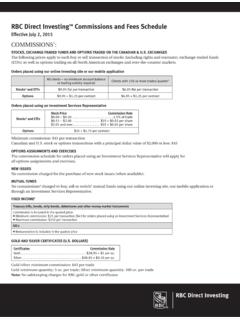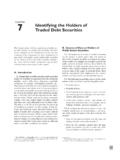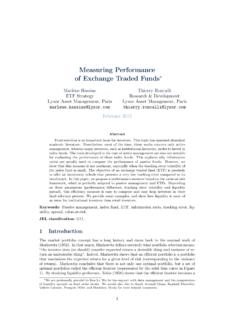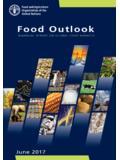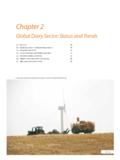Transcription of Understanding the Tax Implications of Exchange-Traded Funds
1 Understanding the Tax Implications of Exchange-Traded Funds 11/21/2003 1 Forward Barclays Global Investors Canada Limited (Barclays Canada) is pleased to present " Understanding the Tax Implications of Exchange-Traded Funds ", a memorandum prepared by PricewaterhouseCoopers LLP. A key component of the Exchange-Traded fund (ETF) advantage is tax efficiency. Our goal with this memorandum is to provide Canadian individuals and institutions with a useful reference material regarding the taxation of ETFs, from an authoritative source, and to highlight the potential tax efficiencies that ETFs may offer. We hope the reader will find this memorandum to be a useful tool in making the most of his or her investment in ETFs. Barclays Canada is an indirect subsidiary of Barclays PLC and part of BGI, one of the largest institutional investment managers in the world and the largest manager of index Funds . BGI leads the world in ETFs by a large margin, with Funds covering a complete range of asset classes.
2 As of October 2003, BGI offered more than 90 ETFs, including 12 in the UK, 12 in Canada, and more than 70 in the US. Barclays Canada currently manages more than $6 billion in ETFs. The i60 iUnits fund is one of the largest mutual Funds in the Canadian equity category and the largest index fund across all categories. With approximately $35 billion under management. Barclays Canada has offices in Toronto and Montreal. 11/21/2003 2 Understanding the Tax Implications of Exchange-Traded Funds Executive Understanding the Tax of Exchange-Traded What is Tax Efficiency?..7 Tax Aspects of Traditional Mutual A Comparison of ETFs and Mutual Funds 9 Indexing and Low Low Cash Superficial Loss Rules Other Tax Aspects of Asset Allocation ETF Call Put Short Based ETFs: Canadian Tax Foreign Investment Entity (FIE) Withholding Canadian Tax on Holdings of US Estate Conclusion 20 Foreign ETFs May Be Tax ETF Tax Appendix Capital Tax Implications of Investing in Corporations that are not Financial Corporations that are Financial 11/21/2003 3 Appendix US Withholding Tax Implications for Tax Exempts holding Appendix An ETF Capital Gains Advantage for Insurance Companies and Other Financial 24 Appendix ETF Advantage for Investment Corporations and Pooled Appendix Structure of Barclays Global Investors 11/21/2003 4 Executive Summary Exchange-Traded Funds (ETFs)
3 , for purposes of this article, are Funds that track or replicate a specific index and are listed and traded on major and Canadian stock exchanges just like individual As is the case with any stock that trades on an exchange , buyers can purchase ETFs from current holders at any time throughout the trading day via their broker. This is different from a traditional mutual fund , of which units can only be bought or sold (usually at the end of the day) from the fund itself. The impact of taxes is an important factor in evaluating and selecting investments. Most ETFs are structured to operate in a manner that may promote tax efficiency for the investor. Some of the tax advantages of Canadian ETFs include: Reduced capital gains distributions: o Low Portfolio Turnover: Index-linked ETFs track the underlying index and thus trade securities infrequently; o Reduced Redemptions: The market maker on the exchange and other dealers will take excess supply of units into their inventories when there are more sellers than buyers.
4 Redemptions will be triggered only when these holdings are large and sustained over a significant period; and o In-Kind Redemptions: Redemptions from ETFs generally occur as in-kind redemptions. Where an in-kind redemption is made, certain ETFs are structured so that any capital gains realized by the ETF upon the transfer of its property to a redeeming unitholder are allocated specifically to that redeeming As a result, the remaining unitholders should not receive a distribution of capital gains realized by the ETF as a result of other investors in-kind redemptions. Traditional mutual Funds also have the ability to allocate capital gains realized as a result of redemptions to redeeming unitholders and many traditional mutual Funds are currently reviewing whether to adopt such an approach. However, few, if any, traditional mutual Funds have yet to adopt this approach; and 1 While there are also ETFs based on bonds and other securities, this article will deal with ETFs that track shares traded on a particular stock exchange .
5 2 It is our Understanding that it is the intention of the iUnits Funds to allocate capital gains realized by the Funds as a result of in-kind redemptions to redeeming unitholders and that proper mechanisms are in place to allow the iUnits fund to make such allocations. 11/21/2003 5 Superficial Loss Rules Protection: ETFs can provide an alternative investment for proceeds if after a sale of securities an investor desires ongoing exposure to a particular asset class. The following memorandum summarizes the key tax Implications of ETFs for Canadian individuals who hold their investments on capital account3 and discusses how the structure of ETFs may promote tax efficiency. The summary also assumes that the ETFs are held outside a deferred income ETFs are traded on stock exchanges in the same way as shares of a publicly held company. They have some of the same tax-related advantages as Canadian ETFs, and some other advantages: Capital gains dividends paid by ETFs to Canadian residents are not subject to withholding tax; and In-kind redemptions rarely, if ever, generate capital gains distributions to shareholders.
6 Investors must also bear in mind that ETFs are assets for estate tax purposes, regardless of the residence or citizenship of the taxpayer. Each of these considerations is discussed in further detail in the attached memorandum. The attached memorandum is intended to provide general information only. It has been prepared at the request of Barclays Global Investors Canada Limited ( Barclays ), the investment portfolio manager of the iUnit Funds . The information provided by Barclays has not been verified by PricewaterhouseCoopers LLP. The attached memorandum is not an endorsement, an offer to buy or sell securities, and is not intended as, nor should it be relied upon, as advice of any kind. Tax, investment and all other decisions should be made, as appropriate, only with guidance from a qualified professional and in no circumstances in reliance upon the attached memorandum. 3 A gain or loss from the disposition of securities, including ETFs, will be taxed as either an income gain or loss, or as a capital gain or loss.
7 Transactions of the former type are generally referred to as being on income account and transactions of the latter type as being on capital account. The main difference is that a taxpayer is required to report only one-half of capital gains or losses for income tax purposes, whereas income gains or losses are fully reported. 4 In this context, the term deferred income plans refers to registered retirement savings plans (RRSPs), registered retirement income Funds (RRIFs), registered education savings plans (RESPs), and deferred profit sharing plans (DPSPs). 11/21/2003 6 Understanding the Tax Implications of Exchange-Traded Funds Introduction Exchange-Traded Funds (ETFs), for purposes of this memorandum, are Funds that track or replicate a specific equity index. Instead of actively trading a basket of stocks, ETFs track an index by selecting a representative group of stocks. The impact of taxes on investment returns is a significant factor in evaluating and selecting investments.
8 Mutual Funds in particular have received press coverage about their tax efficiency the manner in which the tax laws affect investment returns ultimately produced from owning mutual fund units. While taxes are, of course, only one factor in investment selection, they can be important. Returns from similar investment exposures can vary significantly over time, depending upon the manner in which taxes apply to the investments. This memorandum summarizes the key tax Implications of Canadian ETFs held by Canadian resident individual investors on capital account and discusses how the structure of ETFs may promote tax efficiency. In addition, it describes some of the tax Implications for Canadians who invest in ETFs. What is Tax Efficiency? In general, tax efficiency is driven by one simple concept: delaying tax payable on the appreciation of an investment normally enhances after-tax returns. Stated somewhat differently, if appreciation in an investment is taxed when the position is sold, the return on the investment will normally be higher than if some of the tax is paid earlier.
9 The amount of the tax paid earlier can be viewed as having been removed from the amount invested, thereby reducing the positive effect of compounding. Accordingly, a securities investor who can control his or her tax position by realizing tax only when he or she disposes of securities at a gain will usually derive greater tax efficiency than an investor who incurs tax earlier. 11/21/2003 7 Tax Aspects of Traditional Mutual Funds Canadian ETFs are generally structured to qualify as mutual fund trusts under the Income Tax Act (Canada)5 (the Tax Act ). A mutual fund trust is taxed as an individual at the top marginal rate. However, when a trust calculates its income for tax purposes, it may deduct the amount of income (including taxable capital gains) paid (or made payable) to unitholders during the trust s taxation year. This income will, therefore, be subject to tax only at the unitholder level. A trust cannot allocate losses to its unitholders. However, non-capital losses and net capital losses can be carried forward to reduce income and capital gains earned by the trust in subsequent To ensure that the trust itself is not taxed, the mutual fund will make distributions, which generally are taxable to unitholders when they are made payable to them.
10 The character of the type of income earned by the trust and distributed to unitholders is retained in the unitholders' hands. For example, a trust can designate a portion of its distribution to unitholders to be dividends received from taxable Canadian corporations. As a result, unitholders will be subject to the dividend gross-up and will be able to claim the dividend tax credit with respect to that portion of the distribution. Similarly, a trust can designate a portion of its distribution to be taxable capital gains. Unitholders will be taxable on only one-half of capital gains. Finally, a trust can designate a portion of its distribution to be foreign income and can allocate related foreign tax to unitholders so that they may claim foreign tax credits. If a trust makes distributions that are more than its net income and the non-taxable portion of capital gains allocated to unitholders, the excess will be treated as a non-taxable receipt. This non-taxable receipt is not included in computing income of the recipient but rather reduces the adjusted cost base (ACB) of their units, thereby increasing (decreasing) the amount of capital gain (loss) realized on the subsequent disposition of those units.
